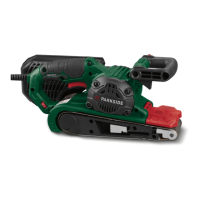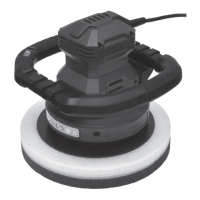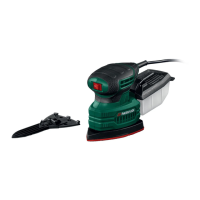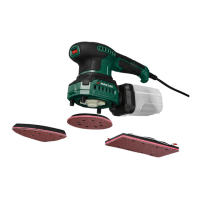Do you have a question about the Parkside PBTS 370 B2 and is the answer not in the manual?
Lists and identifies all numbered parts of the device as shown in diagrams.
Lists all items included in the product packaging with the belt and disc sander.
Describes the intended purpose of the sander, compliance with directives, and user responsibilities.
Guidelines for maintaining a safe and clear workspace to prevent accidents.
Precautions related to power sources, cords, and wet conditions to prevent electric shock.
Advice on staying alert, using PPE, proper attire, and avoiding distractions during operation.
Instructions on using the tool correctly, maintenance, and proper storage of idle tools.
Specific safety guidelines for operating the belt and disc sander, including assembly and handling.
Outlines inherent risks that remain even with proper precautions, emphasizing user awareness.
Details on motor power, dimensions, speed, belt size, and weight of the sander.
Specifies noise pressure and sound power levels, and total vibration values according to standards.
Steps for unpacking the device, checking the scope of delivery, and inspecting for transport damage.
Ensures correct mains power data, safety devices, and free movement of parts before operating.
Detailed instructions for assembling the sanding table, stop rail, and adjusting gaps.
Procedure for safely removing and installing a new grinding belt, noting direction.
How to center the sanding belt on the surface using the adjustment screw.
Instructions on how to adjust the sanding belt's vertical position and secure the grinding table.
Steps to remove the old sanding paper from the disc and attach new paper.
Guidance on securing the sander to a workbench for permanent installation.
Recommendations for using the sander as a portable tool with a mounting plate.
How to operate the power switch safely, with a warning against reaching over the device.
Advice on holding workpieces, pressure, movement, and handling jams during sanding.
How to connect a dust extractor and when not to use it (e.g., for metal).
Instructions on how to properly lift and secure the device for transport.
How to adjust the worktable for grinding angles and the gap to the wheel.
Using the transverse stop for precise sanding of small end surfaces.
How to position the sanding belt for both horizontal and vertical sanding operations.
Techniques for holding and guiding workpieces for surface sanding on the belt.
Proper method for sanding concave curves using the idler drum, with safety warnings.
Correct technique for sanding convex curves using the disc, with safety warnings.
Routine cleaning, oiling of moving parts, and avoiding corrosive agents.
Advice on cleaning after use and regular lubrication of all moving parts.
How to regularly remove dust from the sander for optimal performance.
Identifies parts subject to wear and those required as consumables, like abrasives.
Lists specific accessory items like sanding belts, paper, and safety goggles with their part numbers.
Recommendations for storing the device and accessories in a dark, dry, and frost-free environment.
Details on motor connection, mains voltage, extension cable requirements, and compliance with VDE/DIN.
Warning about using damaged cables and safety information for replacing mains connection cables.
Guidance on proper disposal of the device and accessories, and avoiding household waste.
Information on the environmentally friendly nature of the packaging and its disposal at recycling centers.
A table listing common issues like motor not starting or belt coming off, with their causes and solutions.
Explains the terms of the guarantee, exclusions, and procedures for making a claim.
Provides hotline and email addresses for service support in various regions.
Visual diagram showing all device parts with corresponding numbers for reference.
Lists and identifies all numbered parts of the device as shown in diagrams.
Lists all items included in the product packaging with the belt and disc sander.
Describes the intended purpose of the sander, compliance with directives, and user responsibilities.
Guidelines for maintaining a safe and clear workspace to prevent accidents.
Precautions related to power sources, cords, and wet conditions to prevent electric shock.
Advice on staying alert, using PPE, proper attire, and avoiding distractions during operation.
Instructions on using the tool correctly, maintenance, and proper storage of idle tools.
Specific safety guidelines for operating the belt and disc sander, including assembly and handling.
Outlines inherent risks that remain even with proper precautions, emphasizing user awareness.
Details on motor power, dimensions, speed, belt size, and weight of the sander.
Specifies noise pressure and sound power levels, and total vibration values according to standards.
Steps for unpacking the device, checking the scope of delivery, and inspecting for transport damage.
Ensures correct mains power data, safety devices, and free movement of parts before operating.
Detailed instructions for assembling the sanding table, stop rail, and adjusting gaps.
Procedure for safely removing and installing a new grinding belt, noting direction.
How to center the sanding belt on the surface using the adjustment screw.
Instructions on how to adjust the sanding belt's vertical position and secure the grinding table.
Steps to remove the old sanding paper from the disc and attach new paper.
Guidance on securing the sander to a workbench for permanent installation.
Recommendations for using the sander as a portable tool with a mounting plate.
How to operate the power switch safely, with a warning against reaching over the device.
Advice on holding workpieces, pressure, movement, and handling jams during sanding.
How to connect a dust extractor and when not to use it (e.g., for metal).
Instructions on how to properly lift and secure the device for transport.
How to adjust the worktable for grinding angles and the gap to the wheel.
Using the transverse stop for precise sanding of small end surfaces.
How to position the sanding belt for both horizontal and vertical sanding operations.
Techniques for holding and guiding workpieces for surface sanding on the belt.
Proper method for sanding concave curves using the idler drum, with safety warnings.
Correct technique for sanding convex curves using the disc, with safety warnings.
Routine cleaning, oiling of moving parts, and avoiding corrosive agents.
Advice on cleaning after use and regular lubrication of all moving parts.
How to regularly remove dust from the sander for optimal performance.
Identifies parts subject to wear and those required as consumables, like abrasives.
Lists specific accessory items like sanding belts, paper, and safety goggles with their part numbers.
Recommendations for storing the device and accessories in a dark, dry, and frost-free environment.
Details on motor connection, mains voltage, extension cable requirements, and compliance with VDE/DIN.
Warning about using damaged cables and safety information for replacing mains connection cables.
Guidance on proper disposal of the device and accessories, and avoiding household waste.
Information on the environmentally friendly nature of the packaging and its disposal at recycling centers.
A table listing common issues like motor not starting or belt coming off, with their causes and solutions.
Explains the terms of the guarantee, exclusions, and procedures for making a claim.
Provides hotline and email addresses for service support in various regions.
Visual diagram showing all device parts with corresponding numbers for reference.












